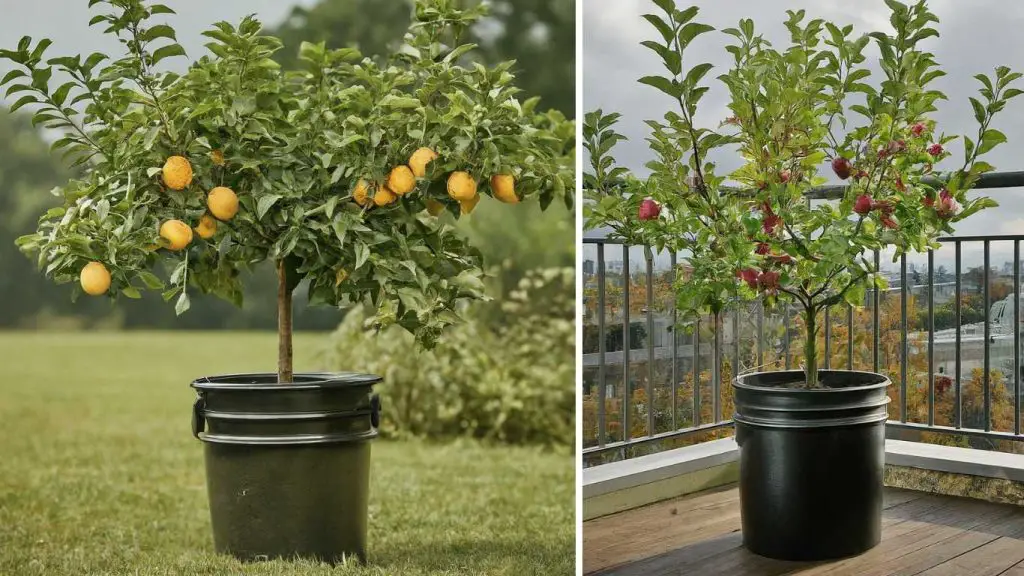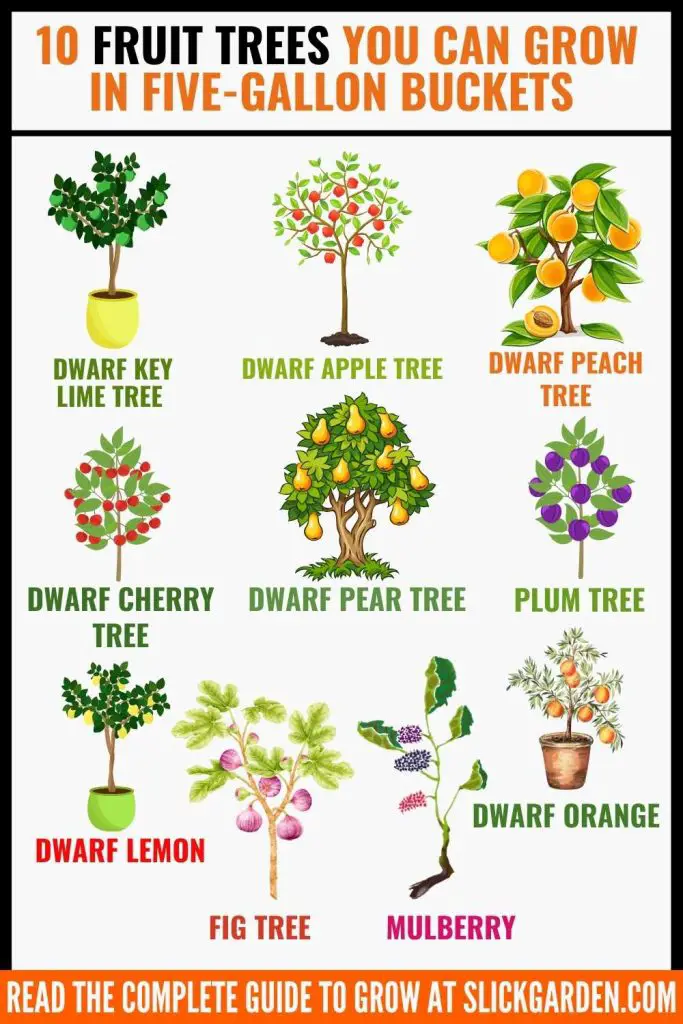Sustainable lifestyles are driving an increase in the popularity of urban gardening. Urban gardeners can create flourishing orchards on their balconies, patios, and windowsills by using five-gallon buckets.

Discover ten fruit tree varieties that are good for container gardening, including citrus and stone fruits. There are professional recommendations on soil types, containers, and maintenance methods.
Both new and seasoned gardeners can benefit from this guide, which will encourage them to grow delicious, fresh fruit at home.
Benefits of Growing Fruit Trees in Five-Gallon Buckets
Space economy, portability, control over soil quality, and disease control are all benefits of container gardening. It is appropriate for urban settings because it makes it simple to plant fruit trees indoors, on patios, or on balconies.
Fruit trees grown in containers have better control over drainage, nutrient levels, and soil quality, which results in healthier and more fruitful trees.
Additionally, they shield against frost, making it possible to grow fruit trees that aren’t hardy in the climate of the area. Containers make harvesting simpler and add beauty and greenery to outdoor spaces when used as decorative elements.
Fruit trees can be grown in containers, which saves room and gives you control over the growing environment. These 10 fruit trees are suitable for growing in five-gallon buckets.

1: Dwarf Key Lime Tree
For a number of important reasons, the dwarf key lime tree is an extremely successful fruit tree that grows well in five-gallon buckets.
Because of their small size, dwarf key lime trees are flexible, compact, and great for container gardening. They are perfect for urban gardeners because they can grow in a variety of environments and small spaces.
Key lime trees grow best in warm, sunny environments, but they can also be grown indoors during the winter. When given the right care, they yield a sizable, tasty harvest.
Container gardening has many uses, is aesthetically pleasing, and requires little upkeep. Regular watering, fertilization, and pruning are necessary for the health and productivity of key lime trees.
Their fragrant blooms and glossy green leaves add a touch of elegance to both indoor and outdoor areas. Having fresh limes in the kitchen enables a variety of culinary creations.
Use premium potting soil, make sure the drainage is adequate, and plant your Key Lime tree in a sunny location for best growth and fruit production.
2: Dwarf Apple Trees
Similar to Key Lime trees, dwarf apple trees are small, which makes them perfect for container gardening in small areas like patios or balconies, or indoors next to a bright window.
Small in stature but abundant in fruit, dwarf apple trees yield crisp, fresh apples. They provide an extensive range of sizes, growing requirements, and flavors.
While some varieties can be self-pollinating, yields can be increased by using multiple varieties or cross-pollinating partners. Even in containers, one can find suitable pollination partners.
Use well-draining potting mix, plenty of sunlight, and appropriate watering to promote fruit production and healthy root development in dwarf apple trees grown in containers.
3: Dwarf Peach Trees
While dwarf peach trees can be grown in five-gallon buckets, they may present different growth challenges than dwarf Key lime or apple trees.
Because dwarf peach trees can get up to several feet in height and width, make sure their container has enough room for them.
Give your peaches enough depth to grow their roots, as they like deep root systems.
Although dwarf peach trees can yield a good crop, growing in containers may limit how frequently they fruit.
Maintaining size, shape, and fruiting potential requires regular pruning. Select a variety that will work for your climate and available space. For healthy growth, proper care entails consistent watering, enough sunlight, and the right kind of fertilizer.
With the right variety selection and growing conditions, dwarf peach trees in containers can still enjoy the beauty and flavor of homegrown peaches, but they do require more care.
4: Dwarf Cherry Trees
Because dwarf cherry trees are compact and good for container gardening, they have lovely spring blossoms and tasty summer fruit, which makes them perfect for growing in five-gallon buckets.
Cherry trees grown in containers are versatile because they are easy to move and have weather protection. In addition to being aesthetically pleasing, dwarf cherry trees also add visual interest to patios and gardens in the spring when they bloom.
Compact dwarf cherry tree varieties are good for container gardening because they grow to a maximum height of 6 to 8 feet when fully grown. Even though they are small, they bear a lot of fruit—fresh, tasty fruit.
Cherry trees require little care, particularly when planted in containers. They only need to be properly watered, given sunlight, and occasionally fertilized.
Choose ‘Stella’ or ‘Compact Stella’ dwarf cherry tree varieties for container gardening. A plentiful harvest of cherries is produced by regular care, well-draining soil, and adequate drainage, which encourage fruiting.
5: Dwarf Pear Trees
Although dwarf pears can be challenging to grow in containers, they can be successfully grown with careful attention to detail and a thorough understanding of their requirements.
Fruit can be produced by dwarf pears when given the right conditions, such as sunlight, watering, and fertilization. Fruit yield can be increased by self-pollinating varieties or cross-pollinating with compatible trees, but space is limited. Another way to increase yield is to have a pollination partner nearby.
Large containers are needed for the roots and canopy growth of dwarf pear trees, as well as deep, well-draining soil for the roots. For optimal root growth and to avoid waterlogging, use a deep container with drainage holes.
Pruning dwarf pear trees on a regular basis is necessary to control their size, shape, and fruit production. They need fertilization, sunshine, watering, and soil moisture monitoring. Trees grown in containers might dry out more quickly than those planted in the ground.
When given the right attention, consideration, and room to grow, dwarf pear trees can flourish in containers and provide delicious and beautiful fruits.
6: Plum Trees
Due to their size and root system requirements, growing plum trees in five-gallon buckets can be difficult, but dwarf plum trees can be grown successfully in these kinds of containers.
The compact growth habits of dwarf or patio plum tree varieties make them perfect for container cultivation constraints. These varieties were bred for growing in containers.
In order to support plum tree roots and avoid waterlogging, which will prevent root rot, choose a large container—between 15 and 20 gallons—with good drainage.
Even though plum trees are smaller in stature, they can produce a sizable crop when grown in containers. They provide home gardeners with a variety of tastes, sizes, and colors. Plum trees also add aesthetic value to outdoor spaces by improving their visual appeal with their lovely foliage and blossoms.
With their size, adaptability, productivity, versatility, and aesthetic appeal, plum trees are a great choice for home cultivation and container gardening in five-gallon buckets.
RELATED ARTICLES:
- List Of Fruit Trees That Grow From Cuttings In Water
- Best Fruit Trees For Small Spaces
- Self-Pollinating Dwarf Fruit Trees
- How To Grow Fruit Trees From Seeds?
7: Dwarf Lemon Trees
For a number of reasons, dwarf lemon trees make a great choice for growing in five-gallon buckets.
Compact and versatile, dwarf lemon trees are ideal for container gardening in cramped areas such as patios or balconies. They are perfect for beginners or those with limited space because they don’t require a lot of sunlight, water, or nutrients. With the right care, they can produce a sizable yield of lemons despite their small size.
Little lemon trees are visually pleasing, adaptable, and have sensory appeal. Their aromatic foliage, delicious fruit, and fragrant blossoms make them perfect for indoor or outdoor gardens. Lemons are useful for a variety of tasks, including baking, cooking, making drinks, and cleaning the house.
Because of their small size, adaptability, productivity, versatility, and aesthetic appeal, dwarf lemon trees are good for home cultivation and grow well in five-gallon buckets.
8: Dwarf Orange Trees
Another excellent choice for growing in five-gallon buckets are dwarf orange trees, which have a number of advantages.
Like dwarf lemon trees, dwarf orange trees are flexible and small, which makes them perfect for container gardening in small areas. They are good for beginners and small spaces because they grow well in sunlight, water, and nutrients.
Despite their smaller stature, dwarf orange trees can produce a sizable crop if given the right upkeep, which includes routine fertilization, pruning, and watering.
Dwarf orange trees have flavor, aroma, adaptability, and aesthetic value. They offer an easy way to get citrus fruit for cooking, baking, or drinks—either fresh or juiced. Their fragrant flowers and glossy green leaves add to the beauty of your container garden.
Because of their small size, adaptability, productivity, versatility, and aesthetic appeal, dwarf orange trees are good for home cultivation and grow well in five-gallon buckets.
9: Fig trees
Fig trees work well in containers, but because of their size and growth habits, they might not work well in five-gallon buckets.
Because they can be grown in containers, fiddle trees are perfect for tiny gardens or urban areas. For slower growth rates, go for compact varieties such as “Brown Turkey,” “Celeste,” or “Petite Negara.”
For fig trees to grow, they require a large container with drainage holes and well-draining soil. Pruning, fertilization, and irrigation on a regular basis promote good fruit production.
When properly cared for, container-grown fig trees can produce ripe, delicious fruits with a distinct flavor and texture that you can eat right from your fingertips.
10: Mulberry Trees
Because of their adaptability and versatility, mulberry trees—especially the dwarf varieties—are perfect for growing in five-gallon buckets.
Because of their small size, versatility, and low upkeep requirements, dwarf mulberry trees are perfect for growing in containers. They fit in most areas because they can withstand a variety of soil types and grow to a height of 6 to 8 feet.
Mulberry trees yield an abundance of juicy berries in containers due to their prolific fruit bearing. They also add visual interest to container gardens with their eye-catching foliage and vibrant fall foliage.
Container gardeners will find dwarf mulberry trees to be the perfect source of fresh, homegrown fruit as long as they receive regular pruning, good drainage, high-quality potting mix, and sunlight.
When selecting fruit trees for five-gallon buckets, take productivity, size, and adaptability into account. Dark orange and lemon trees are the best because of their small size, high yield, adaptability, and visual appeal. Their success depends on proper upkeep and care, which includes access to sunlight, water, nutrients, and the right size container. Savor the satisfaction of eating fruits that you have grown in your container garden.
